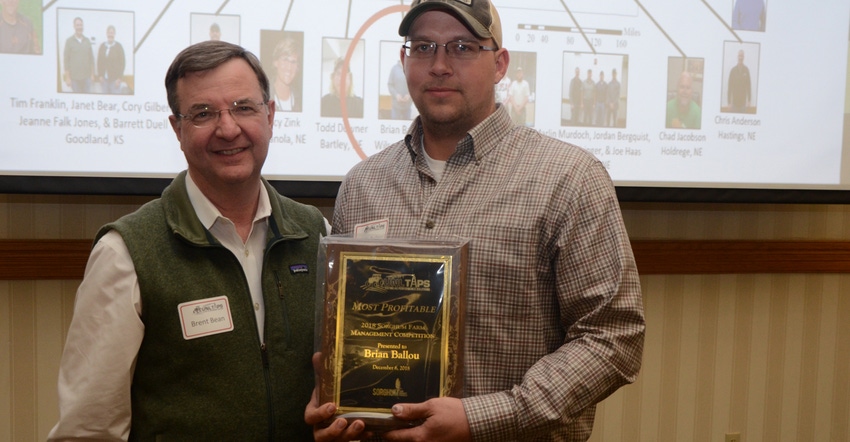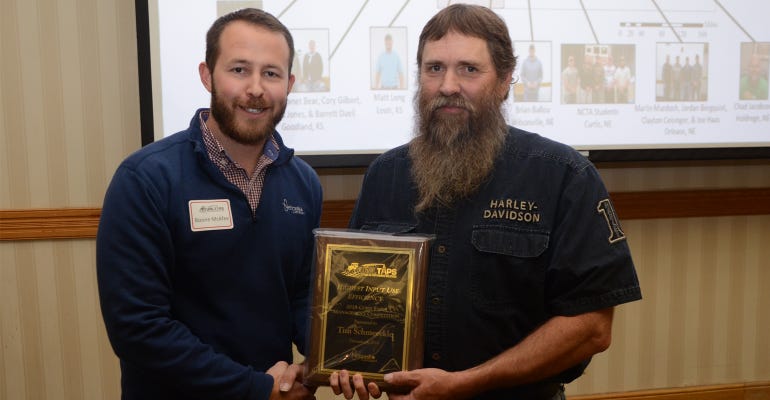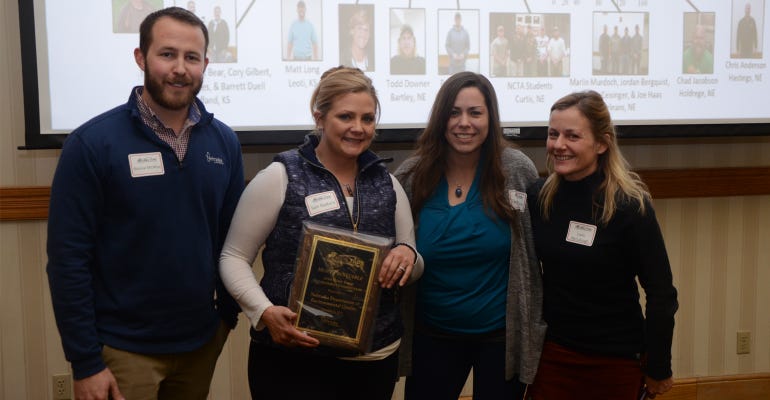
In 2017, Nebraska Extension specialists Daran Rudnick, Matt Stockton, Rodrigo Werle and Extension educator Chuck Burr put their heads together to find a way to encourage crop producers to fine-tune their strategies to drive profitability and input efficiency.
From those conversations, the Testing Ag Performance Solutions (TAPS) farm management competition was born. The competition allows participants to make decisions such as hybrid selection, planting populations, crop insurance, irrigation, nitrogen applications and marketing — all on plots under variable rate-equipped center pivot at the West Central Research and Extension Center at North Platte. The competition also gives contestants a chance to try new technology, including soil moisture sensors, weather stations and aerial imagery.
In 2017, 15 teams — including farmers and Extension specialists and educators — competed for awards for highest corn yield, highest input use efficiency and most profitable. The program expanded in 2018, adding a sorghum competition, with eight teams competing, and 20 teams competing in the corn competition.
The goal of the competition is to encourage growers to make profitable decisions, and all teams generated a profit this year — compared with half of the teams last year, says Rudnick, a Nebraska Extension agricultural water management specialist.
For the corn competition, profitability ranged from $133 to $278 per acre, and for the sorghum competition, profitability ranged from $24 to nearly $182 per acre.

HIGH YIELDERS: Boone McAfee hands the Greatest Grain Yield award for the corn competition to the team from Perkins County — including (from left) Ted Tietjen, Shawn Turner and Troy Kemling. While reaching a yield of 288.5 bushels per acre, this group also was runner-up for most profitable.

"The sorghum competition was quite surprising, because there was such a huge difference between the most profitable farm and everyone else," Rudnick says. "On the corn side, more teams marketed their crop this year compared to last year. They were paying a little more attention to changes in the market, especially early on in the season.
"There was also more control over input use this year. There was less total nitrogen applied — last year it was about 240 pounds per acre on average, and this year it was 225. It looked like the 175- to 200-pound range was the peak nitrogen response. Our estimate for the full irrigation requirement for this year was about 7 to 8 inches, and about half the teams were below that. I think there was a lot more emphasis on irrigation scheduling this year."
Slater Chandler, who raises dryland sorghum on his farm near Imperial, won the award for highest yield at 182.4 bushels per acre.
Meanwhile, Tracy Zink, who farms near Indianola, took home the award for highest input use efficiency. Taking a low-input approach, Zink applied 2.5 inches of water and 72 pounds of nitrogen, with a yield of 155 bushels per acre.

TWO YEARS RUNNING: Boone McAfee hands the award for highest input use efficiency to Tim Schmeeckle of Gothenburg. This is the second year in a row Schmeeckle has won the award. This year, Schmeeckle applied 195 pounds of nitrogen and 4.7 inches of water with a 278.9-bushel-per-acre yield.

Winning most profitable in the sorghum competition was Brian Ballou, who farms near Wilsonville. Ballou's final yield was 179.1 bushels per acre, with a profitability of $182.77 per acre.
What set him apart was marketing. Ballou marketed all his sorghum through the Farmers Business Network's FOB (freight on board) Farm Basis program, which eliminated the cost of delivering grain from the farm site in North Platte to the elevator in McCook.
"They gave me a bid to pick up in the field,” Ballou says. “They had a local market for it, so I went ahead and sold everything through them, because the basis was so much better. I sold some on a spot cash sale early on, but the majority was done with a basis contract, and I locked in the December futures price in late October and early November when we got a bit of a rally."
"At the TAPS kickoff meeting, I talked to Tim Schmeeckle, who won most efficient in the 2018 and 2017 corn competitions, and he convinced me to use split nitrogen applications," Ballou says. "I thought, if I'm going to try it, this is the thing to try in the TAPS competition. That was a totally different mentality than I use on my farm, and now I'm trying it on my own farm in 2019."
Winning highest yield in the corn competition at 288.5 bushels per acre was a group of farmers from Perkins County led by Ted Tietjen. This group also was runner-up for most profitable.
Winning highest input use efficiency (who also had the second-highest yield) for the second year in a row was Tim Schmeeckle of Gothenburg. Schmeeckle applied 195 pounds of nitrogen and 4.7 inches of water, with a 278.9-bushel-per-acre yield.
A team from the Nebraska Department of Environmental Quality had the highest profitability, raising 257.7-bushel-per-acre corn, with a profit of $278.32 per acre. The group also had the second-highest efficiency rating.
Although they are not farmers, NDEQ wellhead protection program coordinator Samantha Radford notes they learned from experts to make decisions, including Roric Paulman, a Sutherland farmer who won the award for most profitable in last year's competition.

LEARNING FROM EXPERTS: Boone McAfee, director of research at the Nebraska Corn Board (one of the sponsors of the competition), hands the award for most profitable to the NDEQ team, including (from left) Samantha Radford, Laura Johnson and Carla McCullough. The group raised 257.7-bushel-per-acre corn, with a profit of $278.32 per acre.

"Roric was really helpful in explaining the difference between grain marketing contracts," Radford says. "In June, the price of corn bumped up to about $4.20 or $4.30. So, we sold up to the 65% we thought we had insured based on established yield — that turned out to be closer to 50% with the higher yields we had this year. In the fall, when we had figured out our yield, we sold the rest."
Radford says the competition also changed her and her team members' perspectives of how they should approach agriculture.
"We try to encourage people to reduce nitrogen use, so we tried to reduce our own nitrogen use and had the second-lowest nitrogen rate,” she says. “We looked at what was in the ground from the previous year — it was 40 pounds of residual N. If we can get people to think about nitrogen efficiency as a function of profitability, that's how we can reduce nitrate loads."
About the Author(s)
You May Also Like






